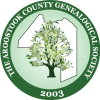From American Heritage May/June 1994:
Typhoid Mary’s name was Mary Mallon. Typhoid is of the Salmonella genus and is mostly spread by contaminated drinking water but, some people were chronic carriers. The carriers were asymptomatic. Perhaps some of the ancestors didn’t die from the water, it was their cook.
As I’ve noted before, pay attention to what was going on in the area and even around the world that had an impact on the relatives. Mount Tambora in Indonesia erupted in 1815. It spewed 100x more material into the atmosphere than Mt. St. Helens. It created the worst famines of the 19th century. Disease will follow famine. Disruption of sanitary practices in the 1810s led to typhoid outbreaks in Europe and the Mediterranean and cholera in other places.
1816 was known as the year without a summer. It snowed in New England in the summer. There was extensive livestock and crop loss. It motivated people to go west because they would starve in the east. The decade of the 1810s was the coldest in the last 200 years. Look for digitized or microfilmed newspapers. There may be correspondence from the folks who left and I believe I’ve read snippets of articles about the numbers of people who left Maine. Don’t forget 1849 and the gold rush. No doubt, it’s a magnet for some.

